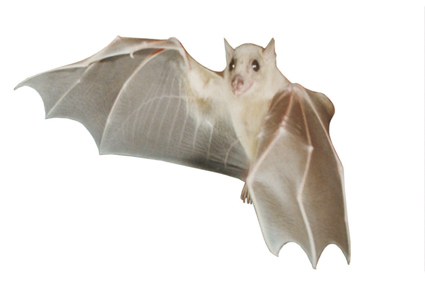Are you a journalist? Please sign up here for our press releases
Subscribe to our monthly newsletter:

Need to track a moving object in the dark? The best method might not be shining your flashlight directly at it. New research on bats shows you could do better by angling the beam a bit to the left or right of your object. The illumination will be dimmer toward the edges of the expanding cone of light, but it will be easier to make out the object’s direction as it moves in relation to the brighter center. In research that recently appeared in Science, Dr. Nachum Ulanovsky and postdoctoral fellow Dr. Yossi Yovel of the Weizmann Institute’s Neurobiology Department showed that bats, which “see” with beams of sound waves, locate an object by aiming their sonar beam to either side of an object, catching it on the cone’s fainter slope, rather than at the central peak.
Animal sonar, or echolocation, is a type of active sensing: The animal must send out a signal in order to get back information on its surroundings. It works remarkably like the sonar that submarines use to find enemy ships: The bats (or ships) emit a sound and listen for the echo, accurately judging the type and location of objects around them by the changes in the sound waves as they’re reflected back. This gives biologists studying echolocation a unique research tool: The mathematical formulas that have been worked out by sonar engineers can generally be applied also to animal echolocation. In keeping with this tradition of applying mathematical thinking to animal sonar, the Weizmann scientists theorized that there should be a trade-off in efficiency between the detection of an object and determining its exact location. For a bat, this could mean that a bug hidden among leaves is best found by focusing with the peak intensity of the sound beam, whereas a large moth flitting out in the open – easy to detect but hard to locate – could best be tracked by aiming the beam off-center to make use of its maximum slope; this turns out to be the most sensitive strategy for detecting changes in the moth’s location.
But are the bats actually behaving according to this prediction – that is, are they able to fit their echolocation strategy to the situation? To answer this question, a research team headed by Ulanovsky trained bats to locate and land on a large black sphere placed randomly in a completely dark room. The bats had to rely solely on echolocation to navigate. A string of special microphones arrayed around the room’s walls traced the sound waves the bats emitted, while two infrared video cameras tracked their flight patterns.
The large Egyptian fruit bats in Ulanovsky’s lab have a unique echolocation system. Unlike many smaller bat species that emit regularly-spaced ultrasonic squeaks, these bats produce their signals in clicks, two at a time. The researchers thought that these double clicks might hold some clues to the bats’ localization strategies. Sure enough, the team, which included Prof. Cynthia Moss and research student Ben Falk from the University of Maryland, found a pattern: The first set of double clicks was aimed left and then right, the next set right and then left. As the bats closed in for a landing, they continued to throw their sound beams to alternate sides of the sphere, just where the mathematical formula predicted they would be most effective. The sphere was designed to be easily detectable, meaning the bat’s optimal strategy was one of localization. To create a situation in which detection was needed as well as localization, the scientists installed a large panel behind the sphere that echoed the sound waves back to the bats’ ears. Now, instead of identifying the sphere’s echo in a quiet room, they had to pick it up out of a battery of noise. This time, as the bats approached their target, they began to narrow their sweep and aim the beams more or less directly toward the sphere.

Ulanovsky: “We were surprised to find that no one had asked these questions before us. Not only did we show that the optimal method for tracking an object is to catch it off-center, on the slope of a beam, we also demonstrated that bats are capable of balancing between detection and localization, and adopting the best strategy according to the particular need.” Active sensing takes place in many situations: Sonar and radar bounce off moving vessels or airplanes, dolphins and whales echolocate in the oceans, dogs track objects by sniffing, and our eyes move in all directions as they interact with our surroundings. Even bacteria use a type of chemical sensing to move toward or away from nearby substances. Ulanovsky and Yovel believe that what works for bats may well work for other organisms: In the future, scientists might find that “sensing on the slope” could be a useful strategy for any or all of these.
Dr. Nachum Ulanovsky’s research is supported by the Nella and Leon Benoziyo Center for Neurological Diseases; the Carl and Micaela Einhorn-Dominic Brain Research Institute; the J&R Foundation; and Rita and Steven Harowitz, Tiburon, CA.